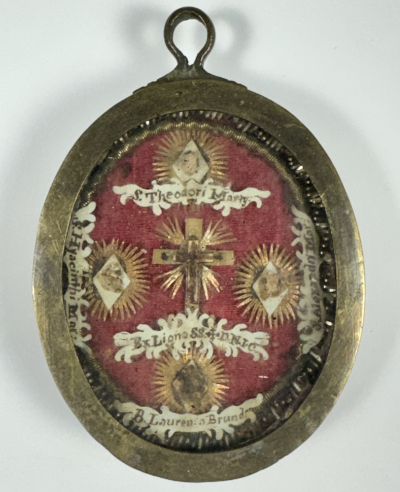The True Cross is a significant Christian relic that is believed to contain physical remnants of the cross on which Jesus was crucified, according to Church tradition. In 326-28, Empress Helena, the mother of Constantine, the first Christian Emperor of Rome, traveled to the Holy Land and discovered what was believed to be the hiding place of three crosses used in the crucifixion of Jesus and two thieves, St. Dismas and Gestas. A miracle then revealed which of the three was the True Cross. Over time, fragments of the True Cross were broken up and distributed widely. In fact, Cyril of Jerusalem noted in 348 that the "whole earth is full of the relics of the Cross of Christ." Many of the small relics of the True Cross found in Europe were obtained from Constantinople after the city was sacked during the Fourth Crusade in 1204. These relics were divided by the present bishops and distributed among knights who then donated them to various churches and monasteries. Today, these fragments remain important symbols of faith for many Christians.
Saint Theodore of Amasea (also known as Theodore Tyron meaning a "recently enlisted soldier or recruit") is venerated as a warrior saint and Great Martyr in the Orthodox and Roman Catholic Churches. Theodore is reported as having destroyed a dragon near Euchaita in a legend not younger than the late 9th century. St Theodore became especially important in the Eastern Orthodox Church, where his cult spread widely and many churches were dedicated to him. The first church dedicated to him in Constantinople was built in 452, and eventually, he had 15 churches in that city. He was famous in Syria, Palestine, and Asia Minor. In Italy, he was shown in a mosaic in the apse of the church of SS. Cosmas & Damian in Rome (dated about 530), and by the next century, he had his own church there at the foot of the Palatine, circular in shape. People brought their sick children to his temple, as to an asclepeion, or healing-temple. He became the first patron of Venice. The chapel of the Doge was dedicated to him until, in the 9th century, Venice wished to free itself from the influence of Byzantium, and he was succeeded by St Mark. The Chartres Cathedral in France has a stained glass window with a series of 38 panels celebrating St Theodore, which date from the 13th century. In the Eastern church, St Theodore of Amasea is celebrated on 8 February or on 17 February or on the 1st Saturday in Lent. In the western church, his date was 9 November, but after the Second Vatican Council and since 1969, he is no longer liturgically celebrated except in certain local calendars. Relics of the saint were widely distributed. In the 12th century, his body was said to have been transferred to Brindisi (Italy), and he is there honored as patron; his head is said to be enshrined at Gaeta (Italy).
Saint Hyacinth of Caesarea (†108) was a young Christian living at the start of the second century, who is honored as a martyr and a saint by both the Eastern Orthodox Church and the Roman Catholic Church. According to tradition, his failure to participate in the ceremonial sacrifices to the official Roman gods came to be noticed by the members of the Imperial household. When he was denounced as a Christian, Hyacinth proclaimed his faith. As a result, he was imprisoned and underwent numerous scourgings and tortures. He was deliberately served only meat which had been blessed for sacrifice to the gods, the eating of which was banned by both Judaism and Christianity. Thus, he starved to death in 108 AD, dying at the age of twelve. Just before his death, legend says, his jailers saw him being comforted by angels, who bestowed a crown on him. His Feast is celebrated on July 3.
Saint Alexander, Bishop of Jerusalem and Martyr (†251 AD) had been imprisoned for his faith in the time of Roman Emperor Alexander Severus. After his release, he came to Jerusalem, where the aged Bishop Narcissus prevailed on Alexander to remain and assist him in the government of that see. Alexander was praised for the library he built in Jerusalem. In spite of his years, he, with several other bishops, was carried off a prisoner to Caesarea, and as the historians say, "The glory of his white hairs and great sanctity formed a double crown for him in captivity". His vita states that he suffered many tortures, but survived them all. When the wild beasts were brought to devour him, some licked his feet. Thrown into prison, he stayed there for quite a long time and died from beheading with a sword. His feast is kept by the Roman Catholic Church on March 18, by the Eastern Orthodox Churches on May 16/29 and December 12/25.
Saint Lawrence of Brindisi (†1619), born Giulio Cesare Russo in Brindisi, Italy, was a Capuchin friar, theologian, and Doctor of the Church. Joining the Capuchins at 16, he took the name Lawrence and excelled in linguistics, mastering several languages, including Hebrew. Renowned for his preaching, he spread Catholicism across Europe, particularly in Germany, countering Protestantism. As a diplomat, he served the Church in missions to Spain, Austria, and Bohemia. Lawrence led troops into battle against the Turks in 1601, armed only with a crucifix. His extensive writings earned him the title "Apostolic Doctor." Canonized in 1881, his feast day is July 21.






 Change language to English
Change language to English